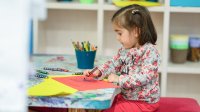How to Make the Most of Classroom Essentials
Early childhood teachers and school leaders can work together to make sure each room has the most effective resources.
Your content has been saved!
Go to My Saved Content.The school year is underway, and teachers have been planning and implementing the resources they need to make both teaching and learning memorable. As with other facets of education, when school leaders work together with teachers to bring the most effective materials into the classroom, everyone benefits.
Here are some essential and familiar resources—with some ideas of how to make the most of them—to help teachers and school leaders collaborate in developing memorable teaching and meaningful, sustainable learning.
Bulletin Boards
While these are normally provided in the classroom, it’s important to consider the following:
- Will different teachers of the same group of learners—for example, a classroom teacher and a makerspace teacher—share the boards?
- Are the bulletin boards within reach of the children? If part of the developmental aim is to foster autonomy and a sense of ownership in the learning process, the children need to be able to interact with the bulletin boards.
- What should teachers and learners use the bulletin boards for? What and how will they post there?
- Should teachers use prefabricated materials for posting to the boards, or should the learners create the materials with the teacher?
It’s a good idea to allow learners to have a say in what to post on the bulletin board and how to post it, but it’s important that teachers provide some guidelines.
For example: The teacher can ask the children what they’d like to display on the bulletin boards to make their class more inviting and then let them discuss, share ideas, and make a decision with the guidance of the teacher.
Once they’ve reached an agreement, the teacher provides materials for the children to create the display. This is a positive way to help learners develop a sense of belonging and feel their work is good enough to be on the bulletin boards.
If the children are working on a class project, they can use the bulletin board as a resource to organize their work to accomplish their goals.
Manipulatives
Teachers seem to collect anything and everything that might be useful in class—from pebbles to leaves, clothes pegs to seashells; you name it, we collect it. These manipulatives can be essential in developing things such as spatial notions, art and construction design, and math lessons.
For example, there are different ways that learners can quantify and create the representation of a number. To represent the number 4, learners might use different combinations of stones—like 2 and 2; 3 and 1; 1,1,1,1—grouping them by different attributes (size, shape, color, material). Learners can also create patterns to complete a sequence or change it.
Manipulatives help learners “touch” concepts and might help them understand those concepts more effectively and successfully—even using them to create a timeline of historical facts.
Other Supplies
Writing, coloring, painting, construction, and crafting materials aren’t just for art class or for working on graphomotor skills; they help children communicate their feelings and emotions and can be helpful with spatial and math concepts and procedures they’ve learned.
Include these materials in the weekly plan, and assign enough time for the children to work with them. As with all other materials and resources, teach the learners how to take care of the materials, the classroom, and themselves—when using paint, for example.
Drawing sheets should be large enough for different collaborative activities. A child might lie down on the sheet while the others outline the child’s silhouette, or a whole group of learners (five or more) could collaborate to work on a task using the drawing sheet.
Colored papers and pieces of cloth, ribbons, and buttons are all materials that might become part of a collage, a drawing dictation, a puppet, or a mosaic, adding texture, color, and an aesthetic component to the learners’ creations. As teachers already know, these materials need to be well organized, in neat containers, and children need to be taught how to keep them clean and organized and how to store them.
Furniture
If teachers had the chance to participate in the decision about what furniture to have in the classroom, it would be much better for the learners. For example, furniture should be movable so that teachers can make different groupings, such as groups of four or five—the creative and critical exchange between students will help them develop a more flexible perspective.
It’s also a good idea to have a large circle carpet (when possible) where all the children can sit and share different ideas. This area can also work as a meeting point, relaxing point, and free activities area.
Lastly, shelves and cupboards need to be within the children’s reach, so avoid shelves that are too high and will make the learner dependent on adults.
Books
Schools generally provide an updated selection of books, but it would be nice to have at least two different types in the classroom: books for the children to read or look at on their own and books to read or share with each other. These should be within the learners’ reach. Also include books that are a bit more difficult and complex that the teacher will read to the students. These should be on the upper shelves of the bookcase.
In some schools, children are asked to bring a book from home and donate it to the class. While that is an idea, schools shouldn’t rely on this to ensure that children have a good enough exposure to good literature. Publishers sometimes collaborate with schools, donating books for the children in return, for example, for being featured in a book fair at the school.
While teachers have the creativity to use these classroom essentials in new and imaginative ways, learners benefit the most when the school works with the teachers to provide the best resources possible.
